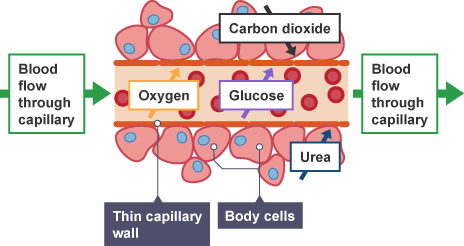Circulation and the Blood
The heart is the centre of the circulatory system, acting as a pump to circulate the blood through the arteries and veins. In humans the larger side of the heart is on the left, but in most animals this is rotated around to the front, since the chest of four legged animals is deeper and narrower.
Blood collects in the left atrium and as it fills, an electrical impulse causes the heart muscle of the first chamber to contract, squeezing blood into the left ventricle. The ventricle is the main pumping chamber of the heart, and when full, it contracts, pushing blood into the main artery in the body (the aorta) and so all around the body.

The arteries carry blood away from the heart, to the organs and tissues where nutrients and oxygen are needed. In the tissues, the blood flows into capillaries, which are very small blood vessels allowing the transfer of nutrients and waste products to and from the cells. Waste products such as carbon dioxide are then carried away from tissues in the circulating blood through the veins, relevant organs then dispose of them.

The veins lead to the anterior and posterior vena cava and onto the right atrium. This collects blood and squeezes it through to the right ventricle. When the right ventricle contracts the blood is pushed through the pulmonary artery to the lungs. Here there is a transfer of the waste carbon dioxide for oxygen. The blood leaves the lungs through the pulmonary vein, back to the left ventricle and the cycle starts again.

The two sides of the heart work in synchrony, the two atrium and two ventricles contracting as pairs. Heart murmurs are heard when the valves in the ventricle leak, allowing an eddy of blood to flow out, which can be heard with a stethoscope.
The Blood
The blood is about 55% plasma with nutrients such as sugar (glucose) dissolved in it. The remaining 45% is cells. The red cells carry oxygen around the body. The white cells are less common and are responsible for fighting infections.
-
Neutrophils kill bacteria
-
Lymphocytes attack viruses
-
Eosinophils defend against parasites and are involved in allergic reactions.
Examining the numbers of each type of cell in a blood sample helps a veterinarian to decide what type of illness an animal is suffering from.

